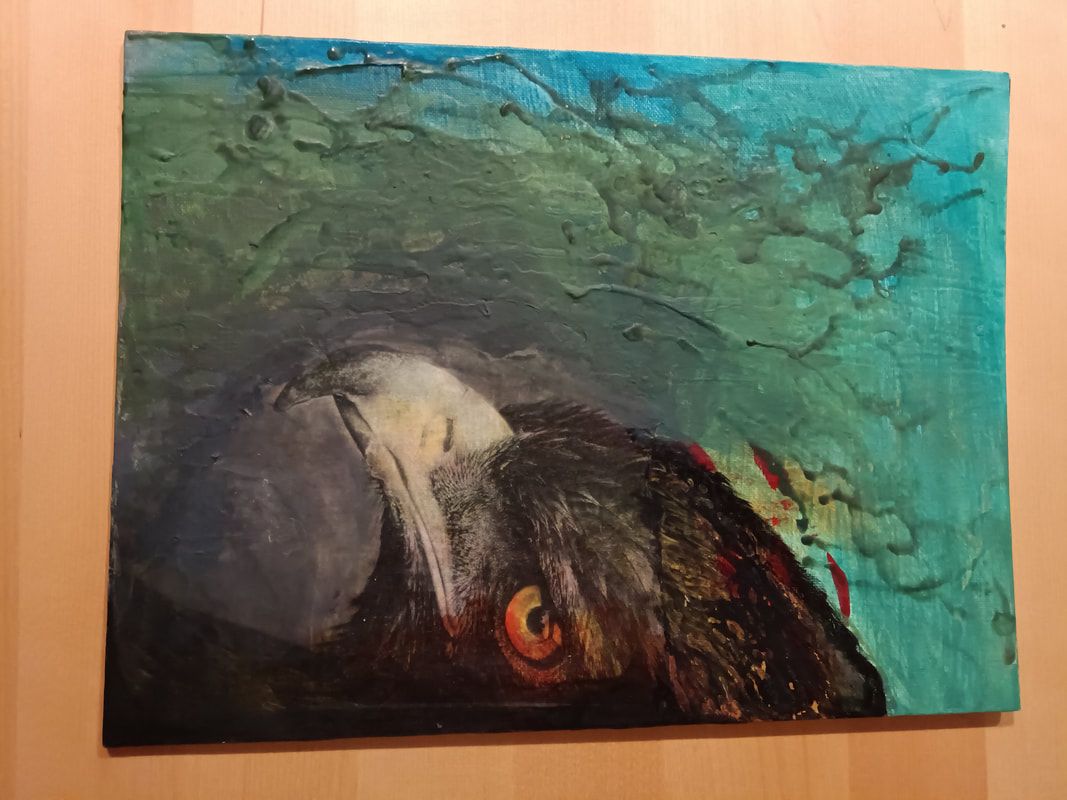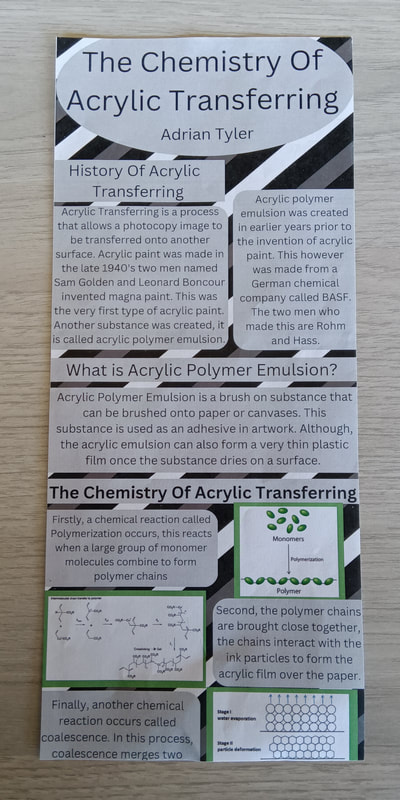Art and Chemistry
In this project, we related art and chemistry together to show off how chemistry ties into art. For the project, we needed to have an art piece of some sorts. The goal of this was to explain the chemistry of the art piece in a specific detailed manner. To do this, I first had to make an art piece that is suitable enough to present. I also had to do a lot of research that consisted of web searches and lots of reading. After some time of gathering some information, I concluded the chemical process in which the art goes through.
The art style that I decided to do is called Acrylic Transferring. In this art style, a photo copy image is printed out in black and white and is transferred to a canvas using a special substance called Acrylic Polymer Emulsion. This image is transferred and turns into a clear layer which has a plastic like texture that is stretchy. This material is the actual image that is transferred and then using the same substance that was used before to transfer the image is used again, although this time it is used as an adhesive. This helps the image stick to the surface of the canvas and glues it down like concrete.
The art style that I decided to do is called Acrylic Transferring. In this art style, a photo copy image is printed out in black and white and is transferred to a canvas using a special substance called Acrylic Polymer Emulsion. This image is transferred and turns into a clear layer which has a plastic like texture that is stretchy. This material is the actual image that is transferred and then using the same substance that was used before to transfer the image is used again, although this time it is used as an adhesive. This helps the image stick to the surface of the canvas and glues it down like concrete.
The Chemical Process Of Acrylic Transferring
The chemistry behind acrylic transferring can be mind blowing although it is also very fascinating in the ways that this happens.
The process starts when the photo copy image is coated in a substance called Acrylic Polymer Emulsion. In this process, the acrylic transfer starts to dry after a few layers is added onto the surface of the paper. A chemical reaction occurs when this happens and it is called Polymerization. In Polymerization, a large group of monomer atoms react and form polymer chains. As the substance dries on the paper, the polymer chains are brought closer to the surface of the paper, since the paper has ink, the ink particles become very close to the polymer chains which allows the particles to link with the chains, this forms a bridge between the two. While this is happening, another chemical reaction occurs and this one is called Coalescence. Coalescence is a chemical reaction that allows two elements to form one mass or whole. In this context, this means that when the substance dries over the paper it forms a very thin layer of acrylic or plastic. This thin layer of acrylic will contain the ink that is taken off of the paper. Once the ink is transferred and the acrylic layer is dry, the acrylic emulsion is used once more to essentially glue the transfer onto the canvas.
Down below you can see my info graphic that I made for this project and my art piece as well.
The process starts when the photo copy image is coated in a substance called Acrylic Polymer Emulsion. In this process, the acrylic transfer starts to dry after a few layers is added onto the surface of the paper. A chemical reaction occurs when this happens and it is called Polymerization. In Polymerization, a large group of monomer atoms react and form polymer chains. As the substance dries on the paper, the polymer chains are brought closer to the surface of the paper, since the paper has ink, the ink particles become very close to the polymer chains which allows the particles to link with the chains, this forms a bridge between the two. While this is happening, another chemical reaction occurs and this one is called Coalescence. Coalescence is a chemical reaction that allows two elements to form one mass or whole. In this context, this means that when the substance dries over the paper it forms a very thin layer of acrylic or plastic. This thin layer of acrylic will contain the ink that is taken off of the paper. Once the ink is transferred and the acrylic layer is dry, the acrylic emulsion is used once more to essentially glue the transfer onto the canvas.
Down below you can see my info graphic that I made for this project and my art piece as well.
This is my art piece, Down below you can see my info graphic that I made for it.


